Going on a long trip with a baby can be tricky, right? But traveling has become much easier for parents thanks to airplane bassinets or baby cots. These bassinets provide a comfy and safe place for your baby to sleep during the flight.
Wondering how to reserve a bassinet and making sure your baby is safe and comfy?
Don’t worry; we’ve got you covered! We’ve put together a complete guide on bassinet seats to help you have a relaxed and worry-free flight with your little one.
Yes, absolutely. The baby bassinet or baby cot is available on airplanes, subject to availability.
However, they are mostly not available in first or business class cabins.
Airplane baby bassinets are special beds designed for infants to use on airplanes, offering a cozy space for your little one to rest during long flights. But not all bassinets are created equal. Airline bassinets come in many different types, sizes, and weight restrictions, which are typically decided by the airline.
It ‘s always better to talk to an airline customer service agent to find our specific requirements for the airline you are flying with.
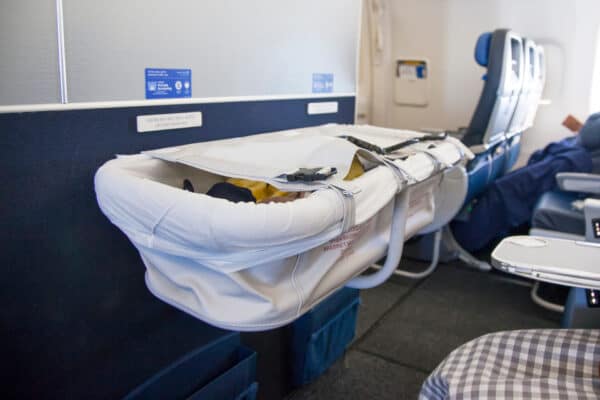
If you are taking a longer flight (typically more than 4 hours) and having a baby as a lap infant (under two years old), getting a seat with a bassinet is a good idea. The baby bassinet will allow your baby to stretch and get some rest while you can also relax during a long journey.
The infant bassinet is designed to accommodate infants weighing up to a certain weight and age, generally around 20-25 pounds and under two years old. However, these may vary based on the airline.
For example, American Airlines allows infants under two years old and 20 pounds, while Air Canada requires infants to be under 25 pounds and unable to sit upright.
Double-checking the size and age restrictions for the Bassinet on each flight is essential so your baby can use it without complications. Knowing your baby has a comfortable resting place during the journey will give you peace of mind.
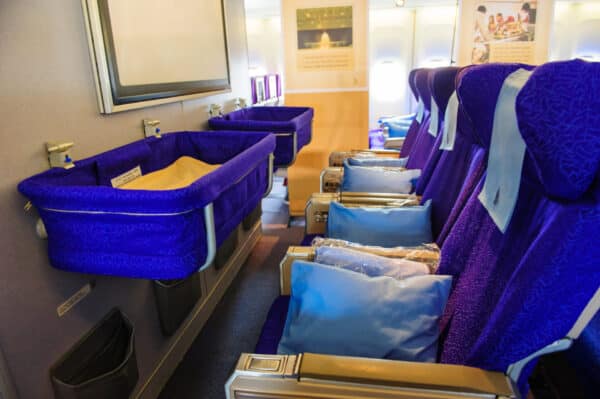
It’s often free of charge, though, some airlines may charge extra for bassinets, especially if you are traveling on a budget airline. Before booking, familiarize yourself with the airline policies, as there may be an additional cost to secure a bulkhead seat.
Most airlines do not allow you to bring your personal Bassinet (the one that has no proper restraint) on the plane due to safety and FAA regulations. Check with your airline if your Bassinet qualifies for air travel.
Securing a baby bassinet can be time-consuming, but providing your infant with a comfortable space during the flight is worth the effort. It’s not as difficult as you may think; let’s look at the step-by-step process for booking a seat with a bassinet.
The most effective way to book a bassinet is to:
These are the bulkhead seats with more space in front so the Bassinet can go on the wall in front of the seat. Generally, the seat numbers will not be assigned to your tickets if you request a bassinet (I know, it’s annoying). It will be assigned at the check-in at the airport.
Many airlines may charge extra for reserving a seat in the designated cot area, so be prepared to pay additional fees if required.
The bassinets onboard are limited, not guaranteed, and are subject to availability. So once your flight tickets are booked, call the airline customer service and request a bassinet. Also, remember to be at the airport early since there are first come first serve basis.
Yes, but It’s not the safest option compared to FAA approved car seat. That being said, it depends on the kind of Bassinet your airline provides.
Most bassinets lack proper restraints to protect your child. The simple Velcro strap across the Bassinet is not sufficient.
On the other hand, some bassinets have three-point harnesses, like one we recently used on the Virgin Atlantic flight to London Heathrow. The Bassinet felt secure; however, it wasn’t deep enough for our son (9 months at the time).

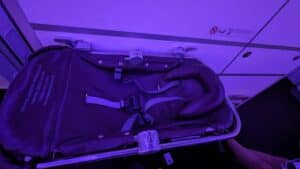
Car seats are generally considered safer than bassinets for air travel, but that requires buying a dedicated seat for your baby. Your baby may find comfort in the familiarity of their car seats, and some airlines, such as Cathay Pacific, advise the use of an FAA approved car seat for infants older than six months.
On the other hand, the bassinets offer more comfort and convenience for long flights, especially when your baby is flying as a lap infant, without buying a separate seat.
As parents, we need to weigh the pros and cons of each option to determine the optimal choice for our child.
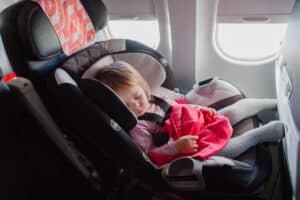
Getting the most out of your bassinet experience means being ready, talking to the right people, and being able to go with the flow.
In this section, we’ll share some helpful advice on how to get your baby ready for the flight, how to communicate your needs to the flight crew, and how to deal with any unexpected bumps in the road.
It’s always best to check with your airline a day or two in advance to ensure you are on the request list for the Bassinet. Sometimes, we book well in advance, and these things may slip from our minds. Also, when you request the first time, a representative may not record it correctly.
In short, it’s always best to confirm that your reservation has a request for a bassinet.
Usually, these requests are first-come, first-serve, especially when there are a lot of babies on your flight. Reaching the airport early and checking in when the counter opens increases your chances of getting a seat with a bassinet.
Sometimes, the bassinets are reserved for younger babies. If your child is older and you check in first, there are still chances they may not assign this to you at that moment. Be persistent and check again at the gate before boarding.
There is always a chance that you may not get a bassinet on the flight (we never had that issue, but prepare just in case). Or your child is uncomfortable in the Bassinet (this happened to us on the Virgin Atlantic flight to London). Then you have to carry your baby on your lap.
These covers, designed specifically to fit over the Bassinet, are a fantastic tool for facilitating better sleep for your baby during flights. By creating a dark and cozy environment, they mimic the familiar feel of a crib at home, making your baby more comfortable and, thus, more likely to sleep.
A product we found particularly effective during our travels was the CoziGo Airplane Bassinet Cover.
This cover not only darkens the Bassinet but also shields your baby from potential distractions in the cabin, helping to maintain a peaceful and serene sleeping space even amidst the hustle and bustle of the flight. It’s lightweight, easy to pack, and simple to use, making it an ideal travel companion for those long-haul flights with your little one.
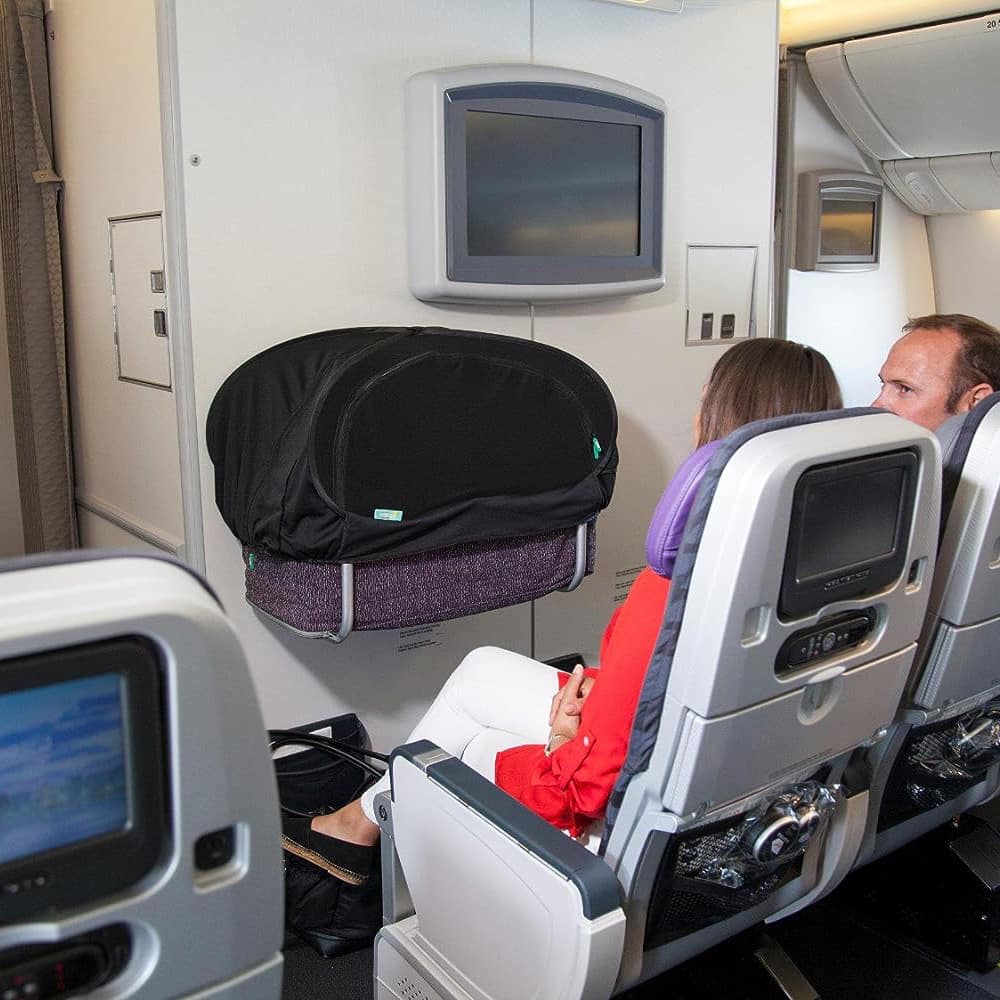
Here’s a little tip – bassinet seats are often located near the airplane’s kitchen or restroom areas. These spots can become a popular hangout for passengers, leading to a bit more noise and activity. But don’t worry; a simple solution could help your baby snooze through the hustle and bustle.
Consider bringing along a white noise machine. This nifty gadget can help drown out the surrounding noise, creating a soothing backdrop that could help your little one sleep peacefully. So, even if the plane gets a bit noisy, your baby can still enjoy their nap time in the Bassinet.
It’s a minor adjustment that can make a big difference in your travel experience!
Remember, airplanes can get a bit chilly because of their high altitudes. They also need to keep the temperature comfy for everyone on board. So, remember to pack an extra blanket for your baby. This will keep them warm and snug during the flight, making the Bassinet even cozier.
So, pop a soft, warm blanket into your bag for your little one. It’s small, but it can help your baby feel comfortable on the flight.
In conclusion, airplane bassinets are an invaluable resource for parents traveling with infants, offering a comfortable and safe space for your little one during long flights. By understanding the various types, size and weight limitations, booking processes, safety features, and airline policies, you can make an informed decision and ensure a smooth and enjoyable flight experience for you and your infant.
Preparation, communication, and adaptability are essential when flying with a bassinet. With these tips, you can confidently begin your next adventure with your baby, knowing you can handle whatever the journey may bring.
Check out our blog post for a PACKING LIST for traveling with infants and babies. You can download a printable checklist covering everything from clothes and toys to baby gadgets and medications.
I admit flying is scary for babies and toddlers. However, it’s all worth it for making new memories at the destination.
Get notified about new travel tips and hacks